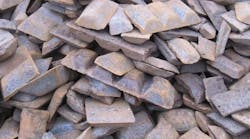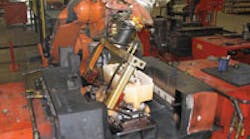Automating specialized tasks requires detailed process know-how and the right hardware to handle castings and cores with power and precision.
In the last 40 years we’ve seen the metalcasting industry expand globally but shrink domestically. Like many other industries, foundries must be looking constantly for new ways to boost their productivity, cut costs and increase quality. Robotic automation is one of these. Robots can provide foundry floor production capability that allows the operators to respond effectively to global pressures and future market changes. Although difficult to measure, this capacity has a clear economic value. A robot can be reprogrammed and retooled so that it can be a valuable tool as customers’ needs change. An automated foundry workcell will reduce direct labor and related cost and reduce the requirements for employee services and facilities.
Justifying Robotic Automation
Justifying robotic systems is a multi-step process. Deciding when to automate and to what degree can be difficult.
Step 1. Technical feasibility study1:
- Is the casting designed for robotic handling?
- Is it possible to do the job with the planned procedure?
- Is it possible to do the job in the given cycle time?
- How reliable will the total system be?
- Can the operators/engineers work with robots?
- Is it possible to maintain safety?
- Can the required quality standards be maintained?
- Can inventory be reduced?
- Can material handling be reduced?
- Is the current material handling systems adequate?
- Castings belonging to the same family
- Castings presently being manufactured near each other
- Castings that can share tooling
- Castings that are of similar, size, dimensions, and weight
- Castings with a simple design
- Will the robotic system meet the direction of foundry’s vision statement?
- Will it meet the foundry’s standardization of equipment policy?
- Will it meet future model changes or production plan?
- Will the plan improve morale of the workers?
- Will it improve the foundry’s reputation?
- Will it improve technical process of the foundry?
- Capital investment cost as compared to changes in profit
- 210-kg robot $85,000
- End effecter $10,000
- Tool changer $3,500
- Programming $20,000
- Peripheral equipment $15,000
- Guarding $4,000
- Installation cost $5,000
- Total $142,500
- Salvage $5,000
- Standard accounting methods are then applied to determine the project’s feasibility
- The values for the components in the cash flow equation are incremental values. They are increases or decreases resulting directly from the project (investment) under consideration.
- The higher the “net present value” (NPV) and rate of return, the better, and the lower the payback period.
- The use of the payback period as a primary criterion is questionable. It does not consider the cash flows after the payback period.
- In the case of evaluation mutually exclusive alternatives, select the alternative with the highest NPV. Selecting the alternative with the highest rate of return is incorrect. This point is made clear in many references (see Stevens (1994), Blank (1989), and Thuesen and Fabrycky (1989).
- In selecting a subset of projects from a larger group of independent projects due to some constraint (restriction), the objective is to maximize the NPV of the subset of projects subject to the constraint(s).
Automation in Permanent Mold Foundries
Aluminum foundries may be poised for growth worldwide. With the massive shift in the automobile industry from iron to aluminum and other light alloys, for both ecological and economical reasons, foundries should be investing heavily in new machinery and automation. Traditional casting methods do not have the flexibility to cast wheels, engine/transmission components, structural components, and more complex parts with thinner walls. Robotics can help to improve quality, consistency, and profitability.
Foundries are a complex and demanding work environment. The automation of specialized tasks requires detailed process know-how and the right hardware to handle castings and cores with power and precision, including:
- Core shooting/machine tending
- Core assembling/gluing
- Core cleaning
- Core handling and placement
- Diecastingmachine tending
- Gravity casting machine tending
- Investment casting dipping and handling
- Ingot handling/furnace tending
- Ladling
- Deburring/deflashing/degating
- Premachining
- Machining center tending
- Inspection/x-ray/leak testing
- By creating products with greater metal integrity, less metal will be needed to be re-worked, reducing wasted throughput time.
- Robotics minimize the amount of spilled metal, because they pour more consistently than individuals can. For example, if a manufacturer pours 100 lb. of metal an hour spilling 10% over the course of an eight-hour shift, and operations run 24 hours/day, 365 days/year, a manufacturer can lose over 40 tons of metal per year — wasting hundreds of thousands of dollars of metal.1
The cell consists of:
- Two eight-station rotary tables with cylinder head casting machines
- One holding furnace
- One pouring robot common to both tables
- One core setting robot common to both tables
- Two extraction robots
- Two cooling tunnels
- Two knockout machines
- Two riser saws
- Two casting exit conveyors.









